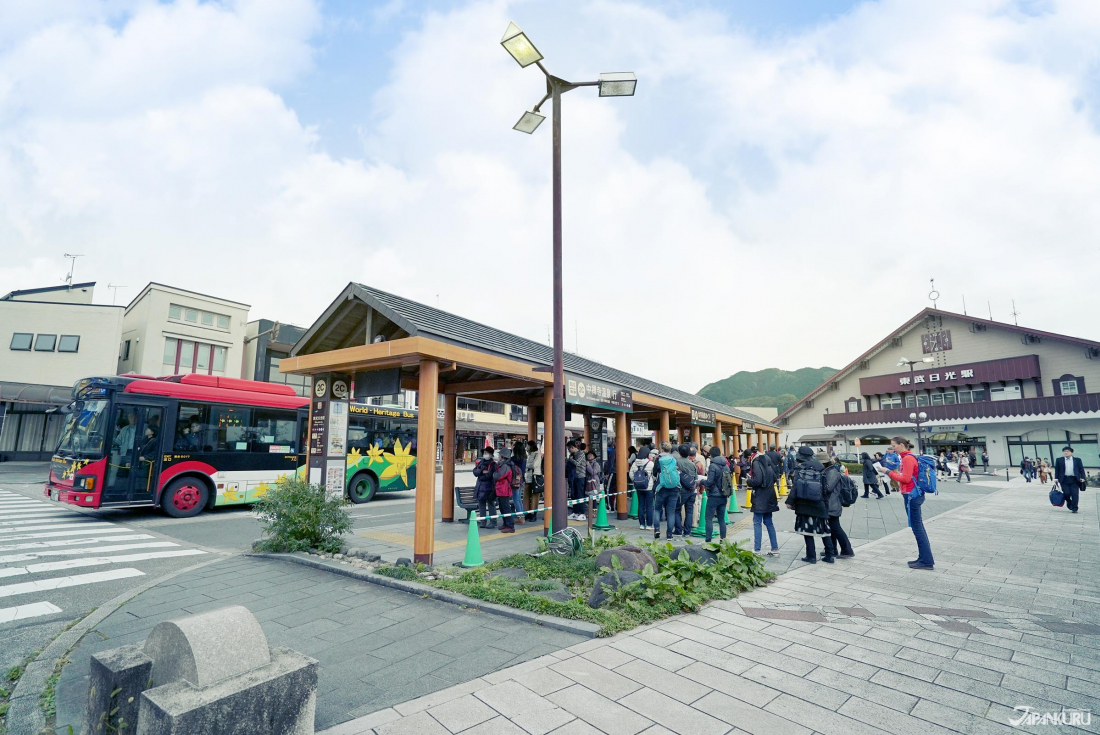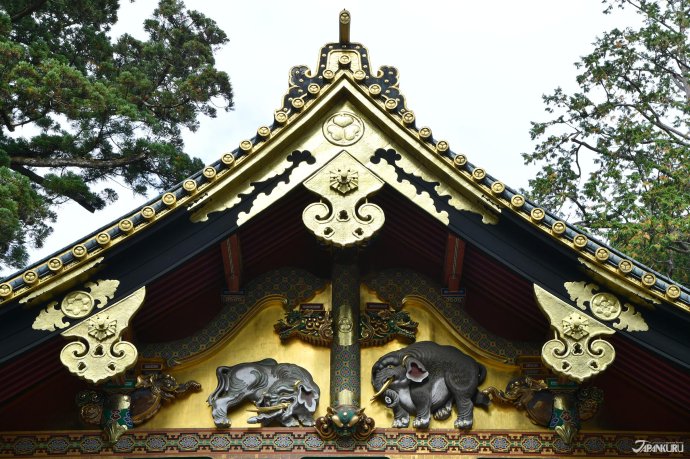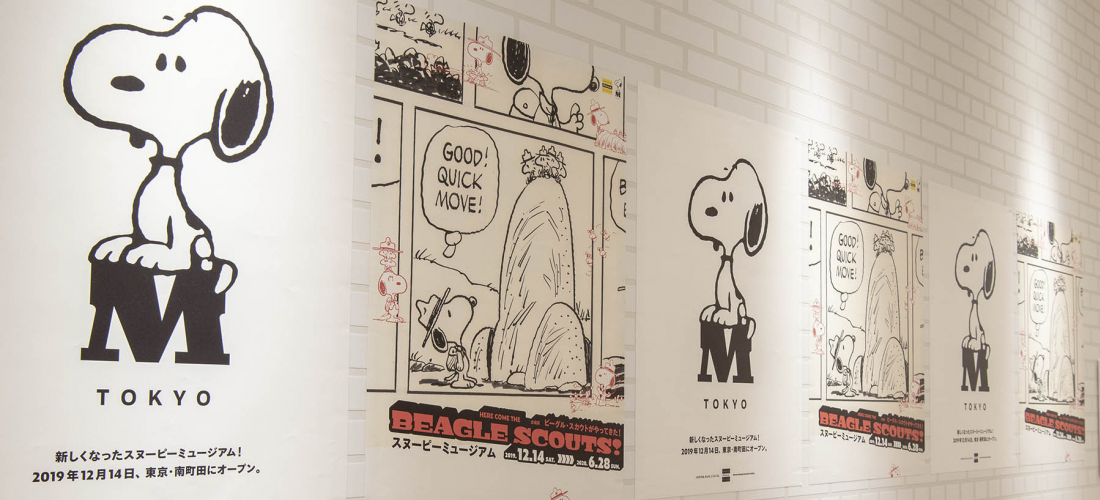CONTENTS
Nikkō, ville inscrite au Patrimoine Mondial de l'UNESCO se trouve à deux petites heures de Tōkyō. On peut facilement y apprécier la nature, les sources sources chaudes, les stations touristiques ainsi qu’une multitude de monuments culturels et historiques. Nous avons décidé de nous déplacer jusqu’à là-bas pour découvrir ces différents lieux!
Il y a un nombre impressionnant de temples et sanctuaires inscrits au Patrimoine Mondial de l’UNESCO mais nous avons décidé de nous arrêter aux 4 principaux :
⦿ Tōshō-gū, sanctuaire immense au coeur de la ville
⦿ Futarasan-jinja, autre sanctuaire important
⦿ Taiyū-in, temple mausolée
⦿ Rinnō-ji, temple situé au pied du Mont Nantai
Nous avons été guidé lors de ce voyage pour en apprendre bien plus que nous l’aurions imaginé!
Laissez-nous vous partager les charmes de la ville de Nikkō.
Comment s’y Rendre?
Vous pouvez vous rendre à Nikkō par différents stations et itinéraires mais la façon la plus simple de rejoindre la ville est d’emprunter les trains de la compagnie Tobu depuis la station d’Asakusa. Petit plus, à Asakusa vous retrouverez le Centre d’Informations Touristiques Tobu. Ici vous retrouverez des réductions pour votre voyage à Nikkō. Il y a un large choix de pass pour les touristes du monde entier.
Page Web (en anglais).
Cette fois nous avons choisi le pass ‘Nikkō City Area’. Ce dernier coûte 2670 yens (environ 20€) et est valide pour 2 jours. Il vous permettra de rejoindre facilement les zones de Nikkō ainsi que de Kinugawa Onsen.
Arrivée à Nikkō
Après un peu moins de 2 heures de trajet nous voici à la station Nikkō Tobu! Juste en face de la gare se trouve des arrêts de bus pour rejoindre les lieux touristiques des environs. Vous trouverez également des services de location de voitures.
Nous aurions très bien pu utilisé les bus touristiques du Patrimoine Mondial mais vue que nous restions ici 2 jours et que nous voulions profiter un maximum des sanctuaires et temples nous avons choisi l’option location. Grâce à Nissan Rent-a-Car notre voyage a été encore plus confortable et pratique.
TŌSHŌ-GŪ (東照宮)
Le Tōshō-gū a été érigé en 1617 sous les ordres d’Ieyasu Tokugawa, premier shogun de l'Epoque Edo (1641-1868). Il est composé de 55 bâtiments et d’une multitude d’escaliers. Il est actuellement en rénovation mais vous pourrez tout de même apprécier une large partie du complex et y prendre de jolies photos.
La Porte Yomei est la partie la plus populaire de ce sanctuaire. Cette dernière est décorée de gravures de toutes sortes : enfants, lions et autres signes traditionnels. Les gravures et couleurs du sanctuaires ont été rénovées sous le troisième shogunnat avec à sa tête Iemitsu Tokugawa (petit fils d’Ieyasu). Elles font de ce sanctuaire un lieu extrêmement apprécié, reconnu comme l’un des plus beaux du Japon.
⏰ : 8h – 17h (fermeture à 16h de Novembre à Mars)
Les admissions se terminent 30 minutes avant l’heure de fermeture.
La ‘Shinkyūsha’ (新厩舎, écurie sacrée) accueillait autrefois les montures sacrées. Lors de notre passage, il n’y avait malheureusement pas de chevaux mais les gravures de singes ont compensé notre malchance. Le lieu est d’ailleurs très populaire pour ces trois singes sages mais nous avons été surpris d’en apprendre encore plus sur l’histoire.
Vous remarquerez certainement que les bâtiments sont décorés d’animaux mystérieux mais savez-vous ce qu’ils représentent? Celui de droite représente un éléphant et à la gauche une girafe! Design assez étonnant nous direz-vous?! C’est tout simplement parce que le Japon n’avait que très peu de connaissances sur ces animaux exotiques à l’époque.
Le “Chat Endormi” est un Trésor National créé par Hidari Jingoro. De l’autre côté vous pourrez voir trois oiseaux! Pour l’anecdote, le chat est le gardien de la tombe des Tokugawa! En temps normal un chat ne dormirez pas en présence d’oiseaux. C’est un symbole de paix : le chat est en paix avec lui-même et son environnement, il n’a pas besoin de tué!
Voici les trois chars en hommage aux divinités des lieux. Ils sont utilisés leur des festivals se tenant au Printemps (le 18 Mai) et en Automne (le 17 Octobre).
Ce bougeoir est un cadeau en guise de bonne entente des Pays-Bas à Ieyasu Tokugawa.
FUTARASAN-JINJA (二荒山神社)
Le Sanctuaire Futarasan se trouve non loin du Tōshō-gū. Bien que le Tōshō-gū soit le plus populaire des deux, le Sanctuaire Futarasan est pour sa part le plus ancien. Sa construction remonte au milieu du VIIIème siècle. Créé dans un premier temps pour vénérer les divinités des montagnes de Nikkō, il est aujourd’hui apprécié des couples qui viennent y faire leurs voeux. Il est dit qu’il apporte bonheur et chance dans le mariage!
⏰ : 8h – 17h (fermeture à 16h de Novembre à Mars)
Purifiez-vous et profitez de la verdure environnante!
Le ‘Shinkyō’ (神橋, pont sacré) fait partie du Sanctuaire Futarasan et est classé parmi les plus beaux ponts du Japon! Nous ne pouvons qu’être d’accord avec cette affirmation.
TAIYŪ-IN (大猷院廟)
Le Taiyū-in, est le mausolée du troisième shogun Tokugawa, Iemitsu, petit fils d’Ieyasu. Comme nous le disions précédemment Iemitsu est à l’origine de la reconstruction du Tōshō-gū, vous retrouverez donc forcément ce style de couleurs délavées.
Le lieu de culte et le sanctuaire intérieur sont reliés donnant une forme en ‘H’ au bâtiment. Ici aussi vous retrouverez de nombreux animaux mystérieux. Nous vous laissons chercher le tapir dans les gravures.
⏰ : 8h – 17h (fermeture à 16h de Novembre à Mars)
RINNŌ-JI (輪王寺)
Le Hall Sanbutsudō du Rinnō-ji a été désigné comme bien culturel important. Il est aussi reconnu comme plus grand bâtiment en bois de la Zone Est du Japon. Il a été construit durant l'Epoque Heian (794-1185) et est actuellement en rénovation jusqu’à 2020. A l’intérieur vous retrouverez d’énormes statues dorées de 7,5m de haut des divinités Bato Kannon, Amida, et Sensu Kannon.
⦿ Bato Kannon : à l’origine cette divinité été vénérée par les guerriers avant les affrontements. Bato protégerait des maladies et de la mort. Aujourd’hui seuls les agricultures le vénèrent encore pour protéger leur bétail.
⦿ Amida : elle est reconnue comme la divinité de la méditation et de la sagesse. Vous la retrouverez à travers le Japon au côté des 4 autres Bouddhas de la sagesse.
⦿ Sensu Kannon : connue sous le nom de ‘Kannon aux 1000 bras’. Elle porte dans chacune de ces mains des objets (lance, flèche, miroir) pour venir en aide à ceux qui prient pour elle.
Restez connectés pour de nouveaux articles originaux tous les jours sur JAPANKURU🐶.
N'hésitez pas à nous suivre également sur nos réseaux Facebook et Instagram pour plus d'histoires japonaises!
Details
NAME:Nikkō
MAP
2301 Sannai, Nikko, Tochigi Prefecture
2307 Sannai, Nikko, Tochigi Prefecture
2300 Sannai, Nikko, Tochigi Prefecture
ACCESS:Station Nikkō Tobu
COMMENT
FEATURED MEDIA
VIEW MORE 
A New Tokyo Animal Destination: Relax & Learn About the World’s Animals in Japan
#pr #japankuru #anitouch #anitouchtokyodome #capybara #capybaracafe #animalcafe #tokyotrip #japantrip #카피바라 #애니터치 #아이와가볼만한곳 #도쿄여행 #가족여행 #東京旅遊 #東京親子景點 #日本動物互動體驗 #水豚泡澡 #東京巨蛋城 #เที่ยวญี่ปุ่น2025 #ที่เที่ยวครอบครัว #สวนสัตว์ในร่ม #TokyoDomeCity #anitouchtokyodome

Shohei Ohtani Collab Developed Products & Other Japanese Drugstore Recommendations From Kowa
#pr #japankuru
#kowa #syncronkowa #japanshopping #preworkout #postworkout #tokyoshopping #japantrip #일본쇼핑 #일본이온음료 #오타니 #오타니쇼헤이 #코와 #興和 #日本必買 #日本旅遊 #運動補充能量 #運動飲品 #ช้อปปิ้งญี่ปุ่น #เครื่องดื่มออกกำลังกาย #นักกีฬา #ผลิตภัณฑ์ญี่ปุ่น #อาหารเสริมญี่ปุ่น

도쿄 근교 당일치기 여행 추천! 작은 에도라 불리는 ‘가와고에’
세이부 ‘가와고에 패스(디지털)’ 하나면 편리하게 이동 + 가성비까지 완벽하게! 필름카메라 감성 가득한 레트로 거리 길거리 먹방부터 귀여움 끝판왕 핫플&포토 스폿까지 총집합!
Looking for day trips from Tokyo? Try Kawagoe, AKA Little Edo!
Use the SEIBU KAWAGOE PASS (Digital) for easy, affordable transportation!
Check out the historic streets of Kawagoe for some great street food and plenty of picturesque retro photo ops.
#pr #japankuru #도쿄근교여행 #가와고에 #가와고에패스 #세이부패스 #기모노체험 #가와고에여행 #도쿄여행코스 #도쿄근교당일치기 #세이부가와고에패스
#tokyotrip #kawagoe #tokyodaytrip #seibukawagoepass #kimono #japantrip

Hirakata Park, Osaka: Enjoy the Classic Japanese Theme Park Experience!
#pr #japankuru #hirakatapark #amusementpark #japantrip #osakatrip #familytrip #rollercoaster #retrôvibes #枚方公園 #大阪旅遊 #關西私房景點 #日本親子旅行 #日本遊樂園 #木造雲霄飛車 #히라카타파크 #สวนสนุกฮิราคาตะพาร์ค

🍵Love Matcha? Upgrade Your Matcha Experience With Tsujiri!
・160년 전통 일본 말차 브랜드 츠지리에서 말차 덕후들이 픽한 인기템만 골라봤어요
・抹茶控的天堂!甜點、餅乾、飲品一次滿足,連伴手禮都幫你列好清單了
・ส่องมัทฉะสุดฮิต พร้อมพาเที่ยวร้านดังในอุจิ เกียวโต
#pr #japankuru #matcha #matchalover #uji #kyoto #japantrip #ujimatcha #matchalatte #matchasweets #tsujiri #말차 #말차덕후 #츠지리 #교토여행 #말차라떼 #辻利抹茶 #抹茶控 #日本抹茶 #宇治 #宇治抹茶 #日本伴手禮 #抹茶拿鐵 #抹茶甜點 #มัทฉะ #ของฝากญี่ปุ่น #ชาเขียวญี่ปุ่น #ซึจิริ #เกียวโต

・What Is Nenaito? And How Does This Sleep Care Supplement Work?
・你的睡眠保健品——認識「睡眠茶氨酸錠」
・수면 케어 서플리먼트 ‘네나이토’란?
・ผลิตภัณฑ์เสริมอาหารดูแลการนอน “Nenaito(ネナイト)” คืออะไร?
#pr #japankuru #sleepcare #japanshopping #nenaito #sleepsupplement #asahi #睡眠茶氨酸錠 #睡眠保健 #朝日 #l茶胺酸 #日本藥妝 #日本必買 #일본쇼핑 #수면 #건강하자 #네나이토 #일본영양제 #อาหารเสริมญี่ปุ่น #ช้อปปิ้งญี่ปุ่น #ร้านขายยาญี่ปุ่น #ดูแลตัวเองก่อนนอน #อาซาฮิ

Japanese Drugstore Must-Buys! Essential Items from Hisamitsu® Pharmaceutical
#PR #japankuru #hisamitsu #salonpas #feitas #hisamitsupharmaceutical #japanshopping #tokyoshopping #traveltips #japanhaul #japantrip #japantravel

Whether you grew up with Dragon Ball or you just fell in love with Dragon Ball DAIMA, you'll like the newest JINS collab. Shop this limited-edition Dragon Ball accessory collection to find some of the best Dragon Ball merchandise in Japan!
>> Find out more at Japankuru.com! (link in bio)
#japankuru #dragonball #dragonballdaima #animecollab #japanshopping #jins #japaneseglasses #japantravel #animemerch #pr

This month, Japankuru teamed up with @official_korekoko to invite three influencers (originally from Thailand, China, and Taiwan) on a trip to Yokohama. Check out the article (in Chinese) on Japankuru.com for all of their travel tips and photography hints - and look forward to more cool collaborations coming soon!
【橫濱夜散策 x 教你怎麼拍出網美照 📸✨】
每次來日本玩,是不是都會先找旅日網紅的推薦清單?
這次,我們邀請擁有日本豐富旅遊經驗的🇹🇭泰國、🇨🇳中國、🇹🇼台灣網紅,帶你走進夜晚的橫濱!從玩樂路線到拍照技巧,教你怎麼拍出最美的夜景照。那些熟悉的景點,換個視角說不定會有新發現~快跟他們一起出發吧!
#japankuru #橫濱紅磚倉庫 #汽車道 #中華街 #yokohama #japankuru #橫濱紅磚倉庫 #汽車道 #中華街 #yokohama #yokohamaredbrickwarehouse #yokohamachinatown

If you’re a fan of Vivienne Westwood's Japanese designs, and you’re looking forward to shopping in Harajuku this summer, we’ve got important news for you. Vivienne Westwood RED LABEL Laforet Harajuku is now closed for renovations - but the grand reopening is scheduled for July!
>> Find out more at Japankuru.com! (link in bio)
#japankuru #viviennewestwood #harajuku #omotesando #viviennewestwoodredlabel #viviennewestwoodjapan #비비안웨스트우드 #오모테산도 #하라주쿠 #日本購物 #薇薇安魏斯伍德 #日本時尚 #原宿 #表參道 #japantrip #japanshopping #pr

Ready to see TeamLab in Kyoto!? At TeamLab Biovortex Kyoto, the collective is taking their acclaimed immersive art and bringing it to Japan's ancient capital. We can't wait to see it for ourselves this autumn!
>> Find out more at Japankuru.com! (link in bio)
#japankuru #teamlab #teamlabbiovortex #kyoto #kyototrip #japantravel #artnews
Photos courtesy of teamLab, Exhibition view of teamLab Biovortex Kyoto, 2025, Kyoto ® teamLab, courtesy Pace Gallery

Japanese Makeup Shopping • A Trip to Kamakura & Enoshima With Canmake’s Cool-Toned Summer Makeup
#pr #canmake #enoshima #enoden #에노시마 #캔메이크 #japanesemakeup #japanesecosmetics

⚔️The Robot Restaurant is gone, but the Samurai Restaurant is here to take its place. Check it out, and don't forget your coupon!
🍣신주쿠의 명소 로봇 레스토랑이 사무라이 레스토랑으로 부활! 절찬 쿠폰 발급중
💃18歲以上才能入場的歌舞秀,和你想的不一樣!拿好優惠券去看看~
#tokyo #shinjuku #samurairestaurant #robotrestaurant #tokyotrip #도쿄여행 #신주쿠 #사무라이레스토랑 #이색체험 #할인이벤트 #歌舞伎町 #東京景點 #武士餐廳 #日本表演 #日本文化體驗 #japankuru #japantrip #japantravel #japanlovers #japan_of_insta

Japanese appliance & electronics shopping with our KOJIMA x BicCamera coupon!
用JAPANKURU的KOJIMA x BicCamera優惠券買這些正好❤️
코지마 x 빅 카메라 쿠폰으로 일본 가전 제품 쇼핑하기
#pr #japankuru #japanshopping #kojima #biccamera #japaneseskincare #yaman #dji #osmopocket3 #skincaredevice #日本購物 #美容儀 #相機 #雅萌 #日本家電 #일본여행 #면세 #여행꿀팁 #일본쇼핑리스트 #쿠폰 #일본쇼핑 #일본브랜드 #할인 #코지마 #빅카메라 #japankurucoupon






















































